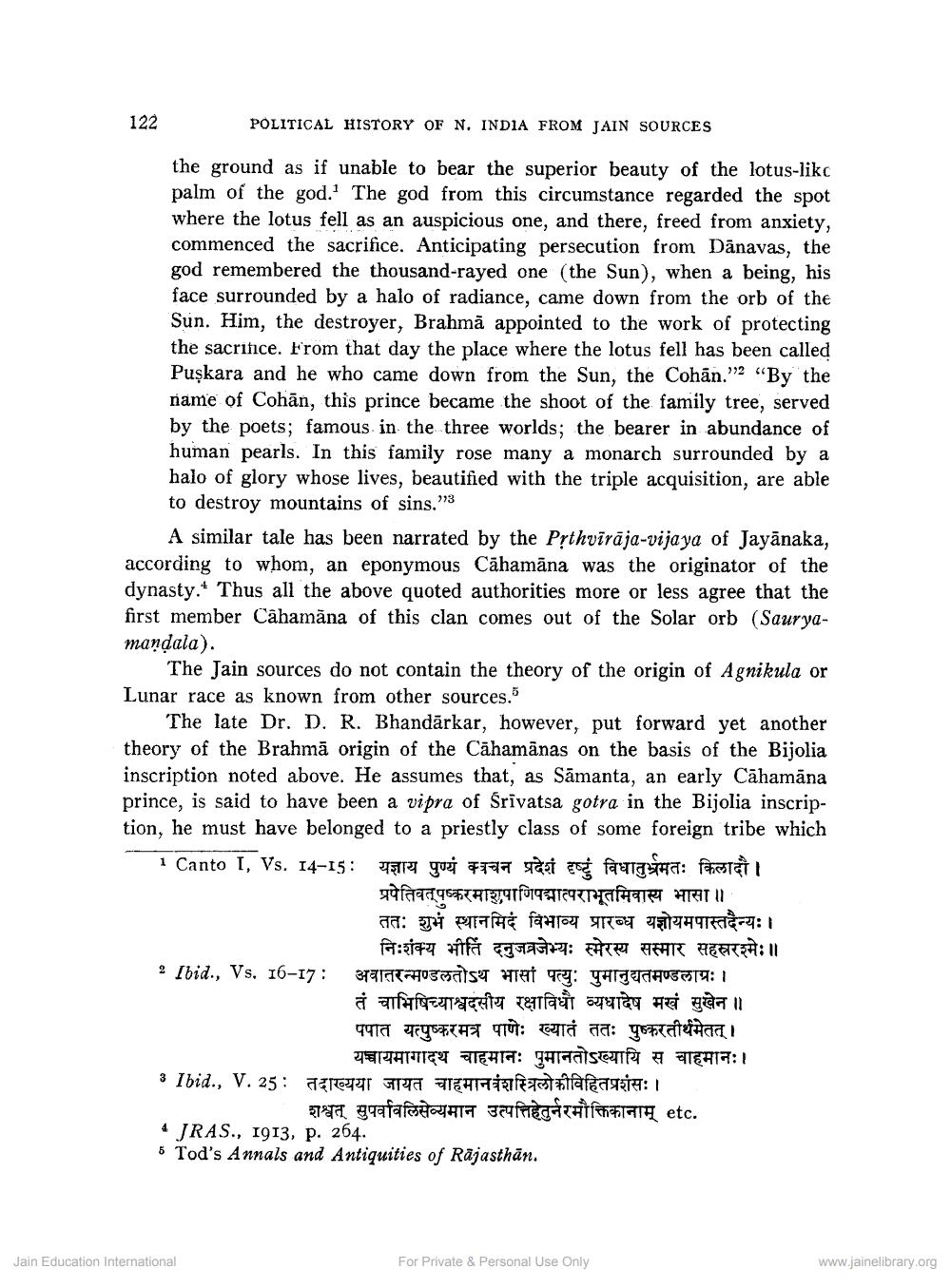________________
122
POLITICAL HISTORY OF N. INDIA FROM JAIN SOURCES
the ground as if unable to bear the superior beauty of the lotus-like palm of the god.' The god from this circumstance regarded the spot where the lotus fell as an auspicious one, and there, freed from anxiety, commenced the sacrifice. Anticipating persecution from Dānavas, the god remembered the thousand-rayed one (the Sun), when a being, his face surrounded by a halo of radiance, came down from the orb of the Sun. Him, the destroyer, Brahmă appointed to the work of protecting the sacrifice. From that day the place where the lotus fell has been called Puşkara and he who came down from the Sun, the Cohān." "By the name of Cohān, this prince became the shoot of the family tree, served by the poets; famous in the three worlds; the bearer in abundance of human pearls. In this family rose many a monarch surrounded by a halo of glory whose lives, beautified with the triple acquisition, are able to destroy mountains of sins.?3
A similar tale has been narrated by the Pịthviraja-vijaya of Jayānaka, according to whom, an eponymous Cāhamāna was the originator of the dynasty. Thus all the above quoted authorities more or less agree that the first member Cahamäna of this clan comes out of the Solar orb (Sauryamandala).
The Jain sources do not contain the theory of the origin of Agnikula or Lunar race as known from other sources.
The late Dr. D. R. Bhandārkar, however, put forward yet another theory of the Brahmā origin of the Cāhamānas on the basis of the Bijolia inscription noted above. He assumes that, as Samanta, an early Cāhamāna prince, is said to have been a vipra of Srivatsa gotra in the Bijolia inscription, he must have belonged to a priestly class of some foreign tribe which 1 Canto I, Vs. 14–15: 75 goj 777 sasi tog fauna tha: S I
प्रतिवत्पष्करमाशुपाणिपद्मात्पराभूतमिवास्य भासा॥ तत: शुभं स्थान मिदं विभाव्य प्रारब्ध यज्ञोयमपास्तदैन्यः।
निःशंक्य भीति दनुजव्रजेभ्यः स्मेरस्य सस्मार सहस्ररश्मेः॥ 2 Ibid., Vs. 16-17: Brangiossatset Hat Tay: YHTETHESTA: 1
तं चाभिषिच्याश्वदसीय रक्षाविधौ व्यधादेष मखं सुखेन ॥ पपात यत्पुष्करमत्र पाणे: ख्यातं ततः पुष्करतीर्थमेतत् ।
यच्चायमागादथ चाहमानः पुमानतोऽख्यायि स चाहमानः। 3 Ibid., V. 25: regg Fra STEHTİTREFT Herennia:
Er gaafarsda FETITEGA TRUFFT etc. 4 JRAS., 1913, p. 264. 5 Tod's Annals and Antiquities of Rājasthān.
Jain Education International
For Private & Personal Use Only
www.jainelibrary.org




